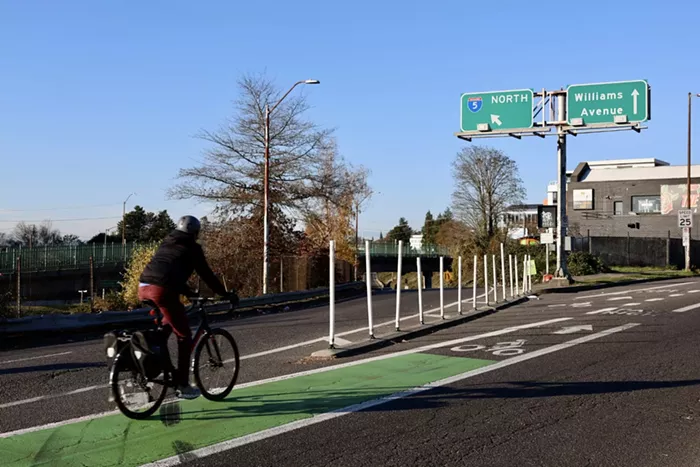
Earlier this week, to the dismay of local freeway fighters, Metro Council moved to allow the Oregon Department of Transportation to get started on the initial phases of its I-5 Rose Quarter project. Given the controversy surrounding the freeway project, the councilors apparently felt they had to justify their decision, responding in part to the large influx of public comment they received from supporters of groups like No More Freeways.
Among the supportive testimony given by members of Metro—the Portland area’s regional planning council— a remark from Metro Councilor Juan Carlos González stood out. He said one reason he wanted to back the project is to “send a message to Salem and DC that this region can and will build big, beautiful things.” González, whose sentiment was echoed by many other his other colleagues on the Council, was referring not only to the freeway expansion, but also the plan to cap I-5 to reconnect the Albina neighborhood, even though that portion of the project is largely unfunded.
From a certain angle, this sentiment makes some sense. ODOT’s Rose Quarter freeway expansion has been in the works for nearly a decade, and the stretch of I-5 looks exactly like it did at the start of the first Trump administration. The plan to replace and widen the I-5 bridge a few miles north has been in development for even longer, with Oregon and Washington transportation departments launching the Columbia River Crossing project in 2005. Meanwhile, the Cascadia Subduction Zone is getting antsier and antsier to destroy the aging bridge, potentially sending a bunch of people into the Columbia River during rush hour. (At least, that’s the narrative project leaders want to convey.)
González’s comment suggests that red tape and bureaucracy have made it impossible for us to get anything done in the Portland metro area. It also reflects the view, shared by other regional leaders (see Mayor Keith Wilson’s refrain that “Portland is dreaming big again”) that Portland’s “recovery” requires spending a lot of money and moving a lot of concrete, presumably with the federal government footing quite a bit of the bill. “Build, baby, build,” these leaders appear to say. What’s getting built, and why, isn’t the main focus.
Even before the new Trump administration took a hatchet to grant programs across all sectors of the government, including transportation, and implemented economically devastating tariffs, this narrative had issues.
Many liberals are evangelizing the idea of “abundance,” as promoted by Ezra Klein and Derek Thompson in their new, popular book that makes the case for growth as the solution to many of the world's woes. A recent piece in Bloomberg’s CityLab points out the limitations of that mindset when it comes to transportation, pointing out the danger in seeing freeway expansion projects as just another piece of prosperity.
“Dramatically expanding driving even further would threaten the planet, public health and urban life,” the article states. “The concept of externalities is enormously important for understanding the greatest challenges currently facing US transportation, including worsening traffic, anemic transit service and a steady drumbeat of crash deaths. Every car trip imposes societal costs in pollution, congestion and safety risks that fall on other road users.”
The Rose Quarter project is more complicated, though, because it’s ostensibly not just a freeway expansion plan. A key part of the project is the inclusion of several blocks of buildable caps over I-5 to spur a renaissance in the Lower Albina area, previously the hub of Portland’s Black community before freeway construction cut it in half, setting off decades of “urban renewal” (AKA gentrification).
The freeway capping plan has been critical for improving the politics of the Rose Quarter plan, and is the only way ODOT has been able to get any federal funding for the project up to this point. Unfortunately, it’s been put on the back burner in a major way, and many are doubtful it will ever get built.
A lot of this is beside the point, though, because we’re living in a new reality. If ODOT actually manages to get its hands on the $450 million it's currently owed from the federal government, there’s not a lot more where that came from. There are, however, other local megaprojects that need federal funding, too.
The plan to replace the Interstate Bridge over the Columbia River, currently estimated to cost between $5-7.5 billion (or more), is heavily reliant on potential funding from the Federal Transit Administration to build the MAX Yellow Line extension to Vancouver. You think President Donald J. Trump wants to help people from Vancouver, Washington enter Portland in a more eco-friendly way? I think not. Without the MAX extension, the proposed bridge replacement is nothing more than an environmental blight on our region, and the whole thing is likely to be killed once again.
As far as non-freeway projects in Portland are concerned, a “federal review” of all bike infrastructure funding could impact plans like the Broadway “civic corridor” project, aimed at making inner Northeast Broadway more bike and pedestrian friendly, as well as plans to improve safety on 122nd Avenue, NE Halsey, and more. I won’t even get into the impact of increased prices from the tariffs, which will make the construction cost increases caused by Covid-era inflation seem like a dream.
So, what do we do? Personally, I’m most inspired by the grassroots work that has always been the beating heart of Portland’s bike and transportation advocacy community. Take the Better Block PSU program, a partnership between Better Block PDX and Portland State University, which encourages students to think creatively and on a community-level about ways to make the city’s streets work better for people.
With limited financial resources, the planners are scrappy and resourceful, and have come up with some of the city’s most beloved pieces of infrastructure (the Better Naito Forever bike lane grew out of a Better Block project, as did Old Town’s Ankeny Alley, and more). With more support from Portland City Council and resources like the city’s clean energy fund, such plans could come to fruition more easily and quickly. There may always be some bureaucratic hoops to jump through to get a project off the ground, but grassroots efforts are more likely to be embraced by wide swaths of the public and recognized for their community benefits.
This isn’t to discount the necessity of big-picture thinking and funding to match. I fully embrace abundance when it comes to dense housing, investments in bike and pedestrian infrastructure, and transit. Bring on the high-speed rail and the solar farms to power it. And, please, listen to community-led organizations like Albina Vision Trust and cap that damn freeway!
But we can’t have all of these things and extra-wide freeways—not if we had the most generous federal partners imaginable, and certainly not in our current reality. Portland can, and should, still dream big. But we’ve got to give up the megaproject pipe dreams and get real. Sending a signal to DC about our “big and beautiful” projects should be the last thing on our minds.








